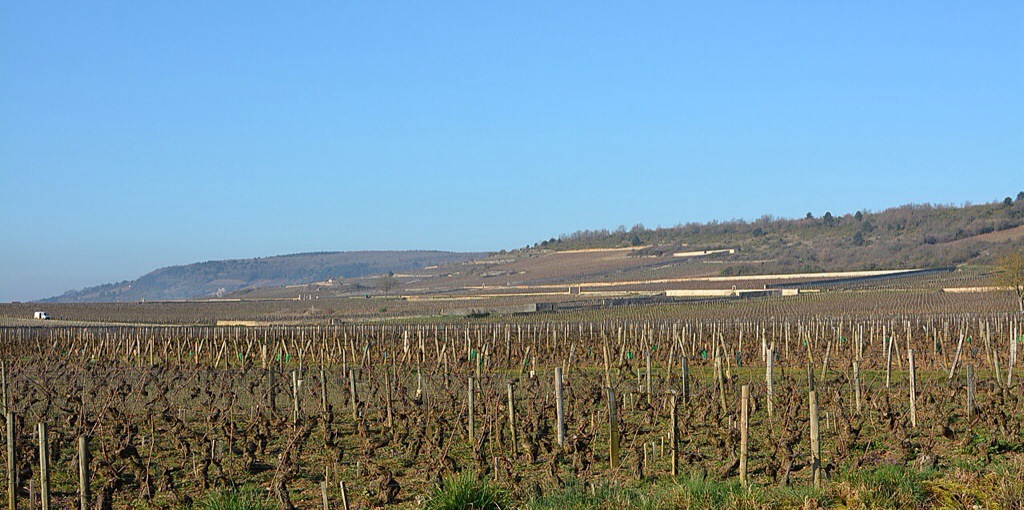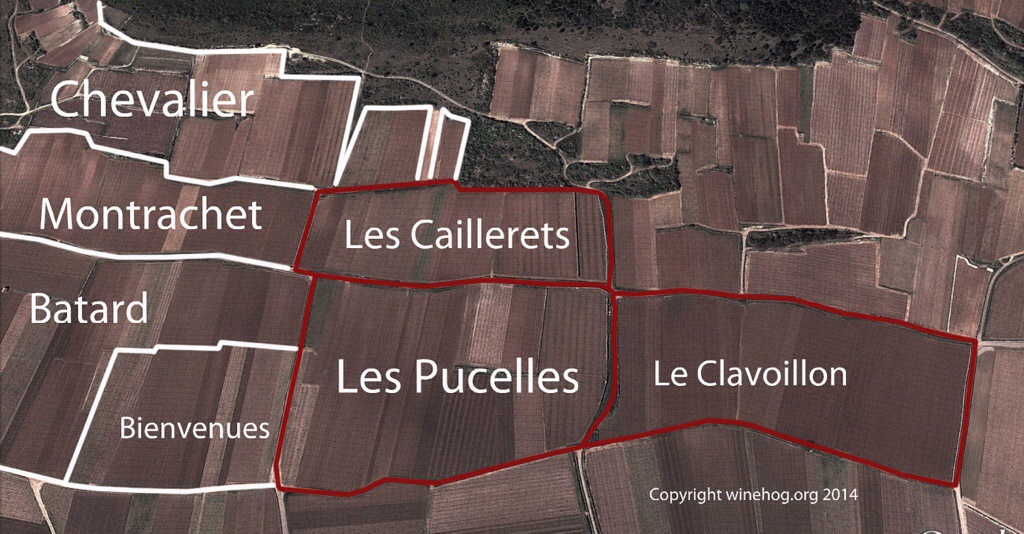Pinot Noir from Chassagne-Montrachet is well known and often provide great pleasure – but red Puligny-Montrachet is virtually unknown today.
Today the village Puligny-Montrachet is associated with gorgeous white Burgundies … and some of the best white wines in the world.
This was however not the case when Lavalle wrote his book in 1855 – quite a few of the famous vineyards in Puligny-Montrachet were producing reds – and these vineyards were therefore not included in Lavalles classification of the white terroirs.

Photo: Les Caillerets, Les Pucelles and Le Clavoillon see from north
The Lavalle Classification of Puligny 1855
Lavalle1 therefore made two classifications of the vineyards in Puligny-Montrachet … one for the whites and one for the reds.
Classification of the white Puligny terroirs1
- Le Montrachet – Tête de Cuvée, Extra
- Les Chavaliers-Montrachet – Premiére Cuvée – en premiére ligne
- Le Blagny-Blanc – Premiére Cuvée
- Le Batard-Montrachet – Premiére Cuvée
- Les Combettes – Premiére Cuvée
- Les Platieres – Premiére Cuvée
- Le Reféres et Les Charmes – Premiére Cuvée
As always Montrachet was mentioned as in a league of its own … with Chevalier-Montrachet as a well ahead of the other Premiére Cuvées. There are two “surprising” vineyards on this list … Le Blagny Blanc .. the vineyard today known as Puligny-Montrachet Hameau de Blagny 1er cru. The other unknown is Les Platieres … still trying to identify the location and history of this vineyard
But at least two of the current top 1er crus of Puligny-Montrachet are missing in this classification … and these are found in the classification of the red terroirs of Puligny.
The red classification included the following well estimated terroirs1:
- Les Caillerets – Premiére Cuvée (5 ha 41 ares 50 cent)
- Le Clavoillon ou Clovaillon – Premiére Cuvée (5 ha 56 ares 10 cent)
- Les Pucelles – Premiére Cuvée (6 ha 80 ares 95 cents)
Especially Les Pucelles and Les Caillerets are today ranked among the very best 1er crus in Puligny-Montrachet and often mentioned among the most obvious candidates for a grand cru classification.
The map below show the location of the old red terroirs … please note that Les Caillerets was significantly larger in 1855 including the northern section of Chevalier-Montrachet (the white two sections above Caillerets) – these sections was included in Chevalier-Montrachet in 1938, 1939 and 1974.
According to Lavalle1 the Premiére Cuvée reds in Puligny were highly regarded in 1855 and many people considered the quality to be on par with the Premiére Cuvées from the Beaune appellation i.e. vineyards like Clos de Mouches, Clos du Roi and Les Boucherottes.
The Rodier Classification in 1920
In 1920 Rodier3 also mentioned the three terroirs Les Caillerets, Le Clavoillon and Les Pucelles as red wine producing vineyards. The classification was however changed as Les Caillerets was the only red Premiéres Cuvée (and only the best part), the lesser plots of Les Caillerets, Les Pucelles and Le Clavoillon were classified as Deuxiémes Cuvées. The lesser parts of Les Pucelles were classified as Troisiémes Cuveée.
Replanting from Red to white – the remaining red!
It’s somewhat unclear when these vineyards were converted from red to white. Many vineyards were replanted with Chardonnay after the phylloxera epidemic … but it seems like the three vineyards mentioned as red by Rodier in 1920 survived the phylloxera and were replanted later. I have tried looking at the age of the vines on these vineyards, and have so far not found plots from before 1944.
To my surprise I discovered that Domaine Jean Chartron is still producing a red Puligny-Montrachet from Clos du Caillerets – a clos located in the northern part of Les Caillerets. According to the homepage of Domaine Jean Chartron6 have a small section – 4 ares and 83 cent (equivalent to 0.0483 ha or 483 square meters ) – on Clos du Caillerets planted with Pinot Noir. The last vines on this section were planted in 1972 and the older plots are from 1957 and 19466.
Domaine Jean Chartron was the only owner on Clos du Caillerets until the mid 1990s. Chartron then sold of most of the holdings in Les Caillerets inkluding Clos du Caillerets – but have kept a part of Clos du Caillerets. The rest of the holdings were sold to Domaine Michel Bouzereau, Domaine Pousse d’Or, Domaine de Montille and Domaine des Lambrays.
Domaine Jean Chartron have also maintained a production of white Clos du Caillerets … where the holdings now are down to 99 ares and 25 cent. The oldest parts of the white section were planted/replanted in 1944, 1945, 1946, 1952, 1955, 1956, 1957 6. The plot acquired by Domaine de Lambrays was planted with Chardonnay in 1946 … thus indicating major replanting just after thed war.
Given this information it’s fair to assume that there were much more pinot noir on these vineyards until around 1945 – and from then on most have been regrafted or uprooted – leaving only a very small section of pinot noir on Clos du Caillerets.
Looking at Clavoillon and Pucelles I have found no evidence of red wine being produced in recent decades. Looking at Domaine Leflaives holdings in these vineyards the oldest plots are from the 1950s. The oldest Lefalive plot in Clavoillon is from 1959 while the oldest vines in Pucelles were planted in 1954 – in the section la grande.
The remaining reds of Puligny-Monctrachet
So far I have only identified one remaining red wine from the three terroirs mentioned by Lavalle in the red classification – Domaine Jean Chartron Clos du Caillerets.
I have however identified a few other reds from Puligny-Montrachet over the years – but I can’t really identify any producers who on a regular basis produce and market red Puligny-Montrachet.
But given this is Burgundy I presume that there are other producers who make red Puligny-Montrachet in small quantities – at least for private use.
The following red Puligny-Montrachets have so far been identified with assistance from the readers:
- Vincent Giradin, Puligny-Montrachet rouge 2005
- Henri Clerc, Puligny-Montrachet rouge
- jean Pascal et Fils, Puligny-Montrachet rouge 2000
Please contact me if you have knowledge about other red Puligny-Montrachets.
References & Sources:
- Jules Lavalle, Histoire et Statistique de la Vignes et Des Grands Vins de la Côte d’Or (1855)
- M.R. Danguy et M. Ch. Aubertin, Les Grands Vins de Bourgogne (1892)
- Camille Rodier, Le Vin de Bourgogne (1920)
- Clive Coates, Cote D’Or (1997)
- Clive Coates, The Wines of Burgundy (2008)
- Domaine Jean Chartron – website


 - A true vin d’émotion – a Burgundy of passion
- A true vin d’émotion – a Burgundy of passion - A truly hedonistic wine – lively and enjoyable
- A truly hedonistic wine – lively and enjoyable - A vivacious wine for pure indulgance
- A vivacious wine for pure indulgance - A potential vin d´émotion - frais et léger
- A potential vin d´émotion - frais et léger